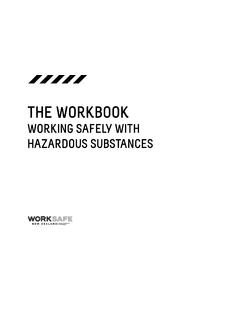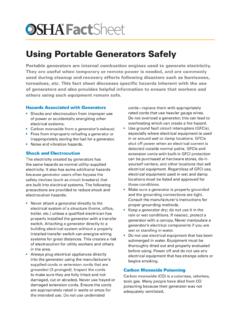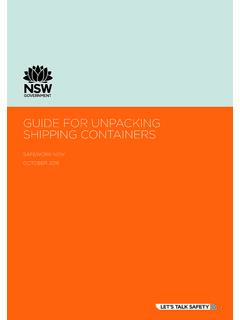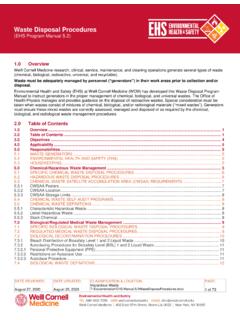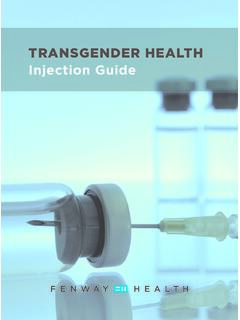Transcription of OSHA 3220-10N 2004
1 OSHA 3220-10N 2004 WORKER SAFETY SERIESWAREHOUSING11 Hazards & SolutionsWarehouse operations can present awide variety of potential hazards forthe warehousing establishments, the10 OSHA standards most frequentlyincluded in the agency s citationswere:1 . Forklifts2 . Hazard communication3 . Electrical, wiring methods4 . Electrical, system design5 . Guarding floor & wall openings and holes6 . Exits7 . Mechanical power transmission8 . Respiratory protection9 . Lockout/tagout10. Portable fire extinguishersOccupational Safety and Health AdministrationThink Safety More than 145,000 people work in over 7,000warehouses.
2 The fatal injury rate for the warehousingindustry is higher than the national averagefor all industries. Potential hazards for workers in warehousing: Unsafe use of forklifts; Improper stacking of products; Failure to use proper personal protective equipment; Failure to follow proper lockout/tagout procedures; Inadequate fire safety provisions; or Repetitive motion Safety and Health Department of Safety and Health AdministrationOccupational Safety and Health AdministrationDocksHazard:Injuries happen here when forkliftsrun off the dock, products fall on employeesor equipment strikes a : Drive forklifts slowly on docks and dockplates.
3 Secure dock plates and check to see if theplate can safely support the load; Keep clear of dock edges and never back up forklifts to the dock s edge; Provide visual warnings near dock edges; Prohibit dock jumping by employees; Make sure that dock ladders and stairs meetOSHA :About 100 employees are killed and95,000 injured every year while operatingforklifts in all industries. Forklift turnoversaccount for a significant percentage of : Train, evaluate and certify all operators toensure that they can operate forklifts safely; Do not allow anyone under 18 years old to operate a forklift; Properly maintain haulage equipment,including tires; Before using a forklift, examine it for haz-ardous conditions which would make itunsafe to operate; Follow safe procedures for picking up, putting down and stacking loads; Drive safely, never exceeding 5 mph andslow down in congested areas or those withslippery surfaces.
4 2 WORKER SAFETY SERIESWAREHOUSING3 Occupational Safety and Health AdministrationOccupational Safety and Health Administration Ensure that the operator wears a seatbeltinstalled by the manufacturer; Never drive up to a person standing in frontof a fixed object such as a wall or stackedmaterials; Prohibit stunt driving and horseplay; Do not handle loads that are heavier thanthe weight capacity of the forklift; Remove unsafe or defective trucks fromservice until the defect is properly repaired; Maintain sufficiently safe clearances foraisles and at loading docks or passageswhere forklifts are used; Ensure adequate ventilation either byopened doors/windows or using a ventila-tion system to provide enough fresh air tokeep concentrations of noxious gases fromengine exhaust below acceptable limits; Provide covers and/or guardrails to protectworkers from the hazards of open pits,tanks, vats and ditches.
5 Train employees on the hazards associatedwith the combustion byproducts of forkliftoperation, such as carbon :Workers can be injured when theyare caught in pinch points or in the in-goingnip points, are hit by falling products ordevelop musculoskeletal disorders associatedwith awkward postures or repetitive : Inspect conveyors regularly; Ensure that pinch points are adequatelyguarded; Develop ways of locking out conveyors andtrain employees in these procedures; Provide proper lighting and working sur-faces in the area surrounding the StorageHazard:Improperly stored materials may falland injure : Stack loads evenly and straight; Place heavier loads on lower or middleshelves; Remove one object at a time from shelves; Keep aisles and passageways clear and ingood SAFETY SERIESWAREHOUSING5 Occupational Safety and Health AdministrationOccupational Safety and Health AdministrationManual Lifting/HandlingHazard:Back injuries may occur fromimproper lifting or : Provide general ergonomics training andtask-specific training.
6 Minimize the need for lifting by using gooddesign and engineering techniques; Lift properly and get a coworker to help if a product is too CommunicationHazard:Chemical burns are possible if spillsof hazardous materials : Maintain a Material Safety Data Sheet(MSDS) for each chemical to which workersare exposed in the facility; Follow instructions on the MSDS for han-dling chemical products; Train employees on the risks of each chemical being stored; Provide spill cleanup kits in any area wherechemicals are stored; Have a written spill control plan; Train employees to clean up spills, protectthemselves and properly dispose of usedmaterials; Provide proper personal protective equipment and enforce its use; Store all chemicals safely and securely; Store chemicals away from forklift SAFETY SERIESWAREHOUSING7 Occupational Safety and Health AdministrationOccupational Safety and Health AdministrationCharging StationsHazard:Fires and explosion risks are possibleunless proper guidelines are : Prohibit smoking and open flames in andaround charging stations; Provide adequate ventilation to dispersefumes from gassing batteries.
7 Ensure that fire extinguishers are availableand fully charged; Provide proper personal protective equipment such as rubber gloves and eye and face protection; Properly position forklifts and apply brakesbefore attempting to change or charge batteries; follow required procedures whenrefueling gas or propane fueled forklifts; Provide conveyors, overhead hoists orequivalent materials handling equipmentfor servicing batteries; Provide an eyewashing and safety showerfacility for employees exposed to ErgonomicsHazard: Improper lifting, repetitive motion orpoor design of operations can lead to muscu-loskeletal disorders in : If possible, use powered equipment insteadof requiring a manual lift for heavy materials; Reduce lifts from shoulder height and fromfloor height by repositioning the shelf or bin; Ensure overhead lighting is adequate forthe task at hand; Provide employees with task-orientedergonomic training; Use your legs and keep your back in a natu-ral position while lifting.
8 Test the load to be lifted to estimate itsweight, size and bulk, and to determine theproper lifting method; Get help if the load exceeds the maximumweight a person can lift safely withoutassistance; Don t twist while carrying a load, but shiftyour feet and take small steps in the direc-tion you want to turn; Keep floors clean and free of slip and SAFETY SERIESWAREHOUSING9 Occupational Safety and Health AdministrationOccupational Safety and Health AdministrationOther HazardsInadequate fire safety provisions, improperuse of lockout procedures and failure to wearpersonal protective equipment also createhazards in the warehouse workplace.
9 Employers should have an emergency planthat describes what is expected of employeesin the event of an emergency, including: Provisions for emergency exit locations andevacuation procedures; Procedures for accounting for all employeesand visitors; Location and use of fire extinguishers andother emergency operations need a lockout/tagoutprogram to prevent equipment from beingaccidentally energized and injuring required to perform these opera-tions should be trained and all employeesshould have a working knowledge of the , management at warehouse operationsneeds to conduct a site hazard assessment todetermine what personal protective equipment(PPE)
10 Must be worn based on the hazards present and train warehouse employees onproper PPE selection, use and Safety ChecklistsThe following checklists may helpyou take steps to avoid hazards thatcause injuries, illnesses and always, be cautious and seek helpif you are concerned about a poten-tial Safety Exposed or open loading dock doors andother areas that employees could fall 4feet or more or walk off should be chainedoff, roped off or otherwise blocked. Floors and aisles are clear of clutter, electrical cords, hoses, spills and other hazards that could cause employees toslip, trip or fall. Proper work practices are factored intodetermining the time requirements for anemployee to perform a task.










